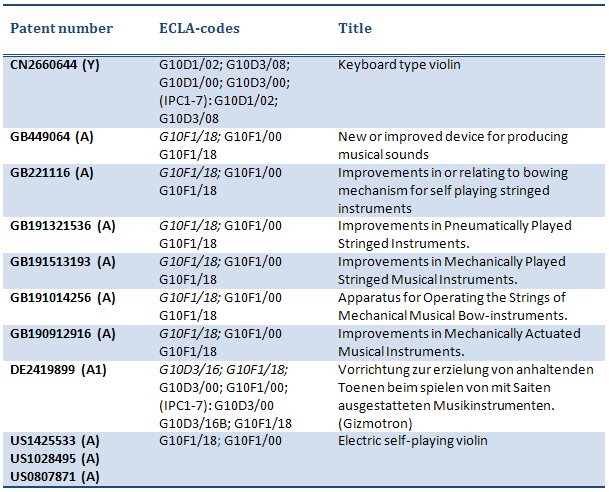Viotar/Patent Research: Difference between revisions
Jump to navigation
Jump to search
Created page with '==Octrooionderzoek Viotar== ===Het ontwerp=== Zoals gezegd is de viotar ontworpen om nieuwe mogelijkheden te creëren op het gebied van strijkinstrumenten. Het belangrijkste uit…' |
No edit summary |
||
| (16 intermediate revisions by 3 users not shown) | |||
| Line 1: | Line 1: | ||
== | {|cellpadding="10" | ||
|-valign="top" | |||
|width="100%" style="border:1px solid #fabd23; background-color:#FEF5DE;text-align: justify;"| | |||
{| padding="0" cellspacing="0" style="margin-top:.2em; width:100%; background:none" | |||
| rowspan="32" width="5px" | | |||
| rowspan="2" class="BGorange1" valign="middle" style="text-align:center; padding:.6em 10px .6em 10px; background-color:#A9D0F5; border-top:2px solid #2E9AFE; border-bottom:2px solid #2E9AFE" | | |||
<h1 style="font-size:180%; border:none; margin:0; padding:0"> | |||
'''Patent Research''' | |||
</h1> | |||
<div style="position:relative; top:.25em; font-size:100%">'''<br/>William Schattevoet<br/>David Duwaer<br/>Eric Backx<br/> Arjan de Visser'''</div> | |||
| rowspan="32" width="10px" | | |||
| rowspan="32" width="5px" | | |||
|- | |||
| | |||
|- | |||
| valign="top" rowspan="30" style="padding:1em 10px 0 10px" | | |||
|} | |||
<br/> | |||
{| cellpadding="10" | |||
|-valign="top" | |||
|width="49%" style="border:2px solid #d73430; background-color:#FBEAEA"| | |||
<h1 style="font-size:180%; border:none; margin:0; padding:0"> | |||
'''Subpages:''' | |||
</h1><br/> | |||
{{:Viotar_Menu}} | |||
=== | |width="2%" style="background-color:#FEF5DE;"| | ||
==== | |width="49%" style="border:2px solid #fabd23;text-align: justify;"| | ||
<h1 style="font-size:180%; border:none; margin:0; padding:0"> | |||
'''Overview:''' | |||
</h1><br/> | |||
Because the Viotar is a brand new instrument, something that’s never been seen before, it might be a good idea to patent the design. Because no one of the group had any experience with patents a lot of research on this topic had to be done. On this page the results of this research is briefly summarized.<br/> | |||
|}<br/> | |||
{| cellpadding="10" | |||
|-valign="top" | |||
| style="border:2px solid #00FF33; background-color:#CCFF99"| | |||
==Patent Research== | |||
===The design=== | |||
As already meantioned, the viotar has been designed to create new possibilities regarding to bowing instruments. The most important thing of this design, is that bowing speed and force are controlled continuously by the system. This has the great advantage that the player himself does not have to control these things, which make playing the instrument more easy and therefor playable for more people. At the same time, this design makes it possible to play chords which is impossible on regular bowing instruments. To meet the requirements, every individual string will be provided with a bowing belt driven by an electromotor. With this, the bowing speed can be controlled for every string individually. To control the bowing force, every bowing belt is also attached to a linear actuator. | |||
===Existing patents=== | |||
====Used ECLA-codes for the research==== | |||
In order to find out which patents already exist on this region, several ECLA-codes have been used for research. The following combinations of ECLA-codes and keywords have been used: | |||
*G10 + String strike | *G10 + String strike | ||
*G10 + Bow wheel | *G10 + Bow wheel | ||
| Line 15: | Line 52: | ||
*G10F + Bow | *G10F + Bow | ||
==== | ====Selected patents==== | ||
From the results of our research, a number of patents has been selected which may have common things with the design of the viotar. This selection is also included in table 1. These patents are chosen because they have at least one aspect that seems to be the same as in our design for the viotar. The patent that has the most similarities with the viotar, is the one on the bottom of table 1 (US1425533 (A)). This patent describes self playing violin from the Mills brothers. Further developments of this design are described in the patents with numbers US1028495 and US0807871. The strings are bowed by little wheels. These wheels are attached to hinges, which push the wheels on the strings using a relais. The idea has strong similarities with the viotar. However, bowing speed and force are not controlled in this design, which is a clear and very important difference. Furthermore, this patent is about a fully automatic violin, where the viotar is played by a musician. | |||
[[File:octrooien.PNG|frame| Border|center| Tabel 1: | [[File:octrooien.PNG|frame| Border|center| Tabel 1: Selected patents ]] | ||
===Viotar | ===Viotar patentable?=== | ||
From the patent research, it is clear to see that the idea of the viotar is not entirely new. There are a few elements from the viotar that can be found in existing patents. For example the idea that all strings are bowed individually by a bowing belt is nog new. Also the electrical drive using keys is found in several patents. However, there is one important thing about the viotar that has not been found in any of them, being the control unit for bowing speed and force. On the base of the results, the idea of controlling bowing speed and force to get a pure tone at all times, could be patentable. The use of bowing belts instead of a regular bow, would not give problems as the found patents are already expired. | |||
Latest revision as of 14:59, 23 March 2011
|
